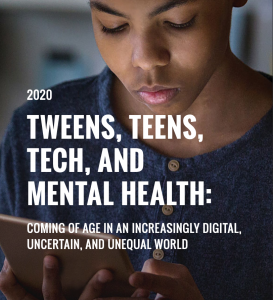Report: Tweens, Teens, Tech, and Mental Health [downloadable]
 In the years leading up to 2020, researchers and advocates expressed growing concerns about a mental health crisis among young people in the United States. Alongside rising rates of depression and suicide, increased social media and technology use seemed like an obvious culprit at first—but the latest findings tell a more complex and nuanced story.
In the years leading up to 2020, researchers and advocates expressed growing concerns about a mental health crisis among young people in the United States. Alongside rising rates of depression and suicide, increased social media and technology use seemed like an obvious culprit at first—but the latest findings tell a more complex and nuanced story.
When the coronavirus pandemic upended our lives, it introduced new social distancing requirements, public health challenges, and social unrest. Almost overnight, school, social activities, and work were all pushed online. It’s too early to know the lasting effects of this radical shift in behavior. Instead, this report seeks to understand how best to reach adolescents who are disproportionately affected and most vulnerable, support them in digital spaces, and improve their mental health outcomes.
The Tweens, Teens, Tech, and Mental Health: Coming of Age in an Increasingly Digital, Uncertain, and Unequal World research report from Common Sense Media synthesizes what is known about adolescents’ mental health and its associations with digital technology use and outlines what stakeholders can do to help.
Selected Findings
1. Digital media and tech can and should be a social safety net right now.
But similar to other social safety nets, many of the most vulnerable adolescents are unable to reliably access and receive support in digital spaces. Household socioeconomic status is one of the most powerful factors shaping both adolescents’ online experiences and their mental health. Adolescents growing up in lower-income households not only have less reliable devices and means of connecting to online spaces, they also tend to receive less supervision, support, and scaffolding in their online activities, and report more spillover of negative online experiences. The coronavirus pandemic has shone a bright light on existing inequalities, and solutions will need to overcome the deep social and digital divides that enable some adolescents to benefit online, while putting many others at risk of being left further behind.
2. Rising depression and risk of suicide among adolescents— young girls in particular—was already a cause for deep concern among parents and mental health providers prior to the pandemic.
Suicides had been increasing among every age group in the United States, but rose most steeply among 10- to 14-year-old girls, with a rate that tripled between 1999 and 2017. Adolescents of color are especially vulnerable: 12.5% of Black and 10.5% of Latina adolescent girls in grades 9–12 reported having attempted suicide at least once in the past 12 months, as compared to 7.3% of White females and 9.8% of Black, 8.2% of Latino, and 6.1% of White male adolescents, respectively.
3. Screen time, and more recently social media use, has been repeatedly identified as a potential cause of adolescents’ worsening mental health symptoms.
This claim is uncertain, but recent meta-analyses and narrative reviews reveal a mix of small positive, negative, and mostly neutral correlations between both screen time and social media use and adolescents’ mental health. Identified associations are small, accounting for less than 1% of the differences between adolescents, and offer no way to separate cause from effect. The failure to find a simple cause of the increase in adolescent depression and suicides is not surprising, given that mental health disorders emerge from a complex set of social, genetic, and experiential factors, which have varying influence across development and situations.
5. Adolescence has always been a critical time to focus on mental health as at least 1 in 5 adolescents are severely impacted and early detection may prevent future suffering.
Most adults (75%) with a psychiatric disorder report symptoms that began before age 18 and symptoms of serious mental disorders, (such as depression), often first emerged in adolescence. In 2000, a nationally representative face-to-face assessment of 13- to 18-year-olds showed that 22% of adolescents met diagnostic criteria for a mental disorder with severe impairment across their lifetime. Over the past 15 years (2005–2018), 1 in 5 adolescents have consistently reported receiving counseling or treatment for mental disorders; however, the types of mental disorders have shifted due to decreases in externalizing disorders (e.g., substance use and conduct disorders) and increases in internalizing disorders (e.g., depression and anxiety).
Screen time is increasing as adolescents move online to meet virtually all their educational and social needs. Flipping the script on screen time to focus on how versus how much digital technology is being used has always made good sense, as counting hours does not distinguish between very different types of online experiences. This change is especially important now as time online needs to be tailored to meet basic and critical educational and social needs of adolescents.
9. Adolescents are increasingly going online to seek information and support related to mental health.
Unfortunately, the majority of digital mental health tools have not been designed with adolescents in mind. This is a missed opportunity particularly during the COVID-19 crisis as digital contact becomes one of the main ways for counselors and other mental health professionals to reach adolescents. Collaborations between mental health providers, developers, educators, parents, and adolescents are required to test whether digital tools can be used safely to detect distress, deliver evidence-based treatments, and extend the reach of existing services. Ideally, these tools could also be used to deliver just-in-time interventions to the adolescents most in need, when they are needed.
Excerpted from “Tweens, Teens, Tech, and Mental Health: Coming of Age in an Increasingly Digital, Uncertain, and Unequal World” from Common Sense Media. Read or download the full report.
Source: Common Sense | Tweens, Teens, Tech, and Mental Health: Coming of Age in an Increasingly Digital, Uncertain, and Unequal World, https://www.commonsensemedia.org/research/tweens-teens-tech-and-mental-health | © 2020 Common Sense Media
Do you need someone to talk to? CHC is here to help. We invite you to call or email our Care Managers at 650.688.3625 or careteam@chconline.org to set up a free 30-minute consultation.





